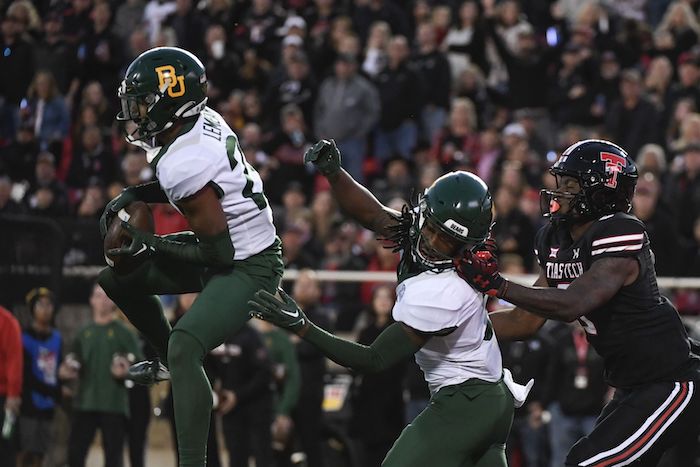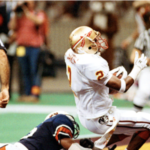Coaching Defensive Backs: Avoiding the Biggest Teaching Mistakes
Whether you have been at it for a while or you’ve just been given the tall task, coaching the last line of defense can be quite the challenge. Outside of quarterback and left tackle, no other position on the field gets more attention and draws more fire than the defensive backs. Developing an entire unit can be a challenge with so many steps involved especially when you consider that most of your group spent their early years playing a different position. As you consider what lies before you along with the varying types of skills and mental approaches by those you are in charge of, take note of the following mistakes that many coaches make. Perhaps you have been guilty of these in the past but even if you were, there’s no better time than the present to fix them and have your unit benefit.
Neglecting Fundamentals
One of the most significant mistakes coaches make is neglecting the fundamentals when teaching defensive backs. It’s crucial to lay a solid foundation by emphasizing proper stance, footwork, and technique. Without a strong fundamental base, defensive backs may struggle with coverage, tackling, and overall execution. Coaches should prioritize teaching and reinforcing fundamental skills regularly, incorporating drills and repetitions to develop muscle memory and ensure proper execution in game situations. There tends to be a focus on teaching scheme and making sure players are where they need to be the varying coverages that coaches run. However, if doing this leaves little to no time for giving your players the tools they need to run those coverages then you are doing too much schematically. They say less is more, consider that in this case. A player without tools and in this case that means technique, will not be able to complete the job.
Lack of Individualized Instruction
Every defensive back is unique in terms of their physical abilities, skill sets, and areas for improvement. Coaches sometimes make the mistake of employing a one-size-fits-all teaching approach, failing to provide individualized instruction to cater to each player’s needs. To maximize player development, coaches should evaluate each defensive back’s strengths and weaknesses and tailor their coaching techniques accordingly. By focusing on specific areas of improvement for each player, coaches can help them grow and excel in their roles. I think we have all be guilty of this one. Perhaps coaches have had success using certain techniques as a player or as a coach of other players. That does not necessarily mean that it will be successful for all of the players you coach. It is difficult for coaches to coach multiple techniques either because they don’t understand them or they have fear of losing the core of their philosophy. Sure, it is a fine line but ultimately, you have to give your players the tools they need to go to work on game day. Don’t take away the abilities of a potentially great player because you do not have the ability to tweak a technique to allow him to have success.
Inadequate Film Study Guidance
Film study is an essential aspect of developing defensive backs’ football intelligence. However, coaches often make the mistake of not providing sufficient guidance and structure in this area. It’s crucial to teach defensive backs how to study film effectively, including how to analyze opponents’ tendencies, formations, and individual player traits. Coaches should offer clear instructions on what to look for, how to break down film, and how to apply the insights gained to on-field performance. By providing proper film study guidance, coaches can help their defensive backs become more prepared, instinctive, and adaptable on game day. So many players leave high school and go through college lacking in this area. After so many years of training, I would dare say that it is one of, if not the main reason why players struggle at the pro level. You have to understand your opponent to defeat them.
Failure to Foster Communication and Cohesion
A cohesive and communicative secondary can greatly enhance a team’s defensive performance. However, coaches sometimes overlook the importance of fostering communication skills among defensive backs. This includes teaching effective verbal and non-verbal communication, such as proper signaling, recognizing offensive formations, and making split-second adjustments. Coaches should create an environment that encourages open communication, emphasizing the role of defensive backs as on-field leaders. By prioritizing communication skills, coaches can improve the overall coordination and effectiveness of their defensive backfield. If you are a majority zone based defense, this point can’t be emphasized enough. Use your walk-through periods to emphasize communication. It is the best time to get your players to understand this aspect of your pass defense. While things are slowed down, make sure they talk to each other and put everyone on the same page when the ball is snapped.
Lack of Player Development Plan
To optimize the growth of defensive backs, coaches need to have a well-defined player development plan. This plan should include progressive skill development goals, specific drills, and measurable milestones. Neglecting to establish a clear roadmap for individual player development can hinder their progress and limit their potential. Coaches should regularly assess their defensive backs’ strengths and weaknesses and design targeted training sessions to address areas that need improvement. By implementing a structured player development plan, coaches can facilitate continuous growth and ensure their defensive backs are on the right track towards achieving their goals. Herein lies one of the major reasons defensive backs transfer. Sometimes it’s not just about them being a backup. If they feel neglected as a backup then they are forced to go elsewhere. Players progress at different levels. Make sure that you are showing proper attention to those who are not yet ready to play. Give them feedback, put them on a schedule and allow them to see improvement towards their goals. There’s nothing worse than being second and having no plan available to become first.
Coaching defensive backs requires careful attention to detail and a commitment to continual improvement. By avoiding common mistakes such as neglecting fundamentals, providing individualized instruction, offering proper film study guidance, fostering communication, and having a player development plan, coaches can enhance their teaching effectiveness. Empowering defensive backs with a strong foundation, personalized coaching, effective film study techniques, and a cohesive communication framework will contribute to their growth and success on the field.
Chad Wilson is the owner of All Eyes DB Camp and author of "101 DB Tips". He played college football at the University of Miami and briefly in the NFL for the Seattle Seahawks. Over his 15 year high school football coaching career, he tutored over a dozen Division I defensive backs and as a trainer has worked with NFL All Pros, first round draft picks, college football All Americans and Top 10 ranked high school football prospects.









